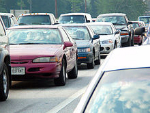 The Federal Highway Administration’s latest monthly report on vehicle miles of travel (VMT) found that in first-quarter 2015, Americans drove 720.1 billion VMT, up 3.9% over first-quarter 2014 and the highest level reached in any year’s first quarter (2006’s record high was 705.7 billion VMT). The increase was even greater in the 13 western states, whose VMT increased 5.3% in March compared with the previous year.
The Federal Highway Administration’s latest monthly report on vehicle miles of travel (VMT) found that in first-quarter 2015, Americans drove 720.1 billion VMT, up 3.9% over first-quarter 2014 and the highest level reached in any year’s first quarter (2006’s record high was 705.7 billion VMT). The increase was even greater in the 13 western states, whose VMT increased 5.3% in March compared with the previous year.
These increases are due to the economic recovery, after America’s deepest recession since the Great Depression. In a presentation at the annual meeting of the American Planning Association in Seattle, in April (prior to the latest FHWA numbers being released in mid-May), commuting expert Alan Pisarski (Editor’s note: Pisarski lives in Northern Virginia and is a noted transportation expert) provided some perspective on what is happening with U.S. trip-making. He pointed out that median income as of 2013, in inflation-adjusted dollars, was still well below the level of 2007. And employment (share of workforce actually working) was also well below that of 2007. Yet even with this weak economic recovery, the 2014 VMT numbers were trending upward.
It’s important to keep in mind, as Pisarski reminded his audience, that the long-term trend of increasing VMT per capita (from the 1960s through 1990s) is almost certainly over. That increase came about due to the Baby Boom, the huge movement of women into the work force, the car boom during the same period, etc. Anti-auto people these days focus on the peaking and subsequent modest decrease in VMT/capita to argue that the need for increased highway capacity is over. But how much capacity we need is a function of total VMT, not per capita VMT, and with the economic recovery continuing, total VMT is growing again, as more people are employed and hence drive more. Total VMT seems well-correlated with population growth and economic growth.
Pisarski also pointed out that every competent projection, including detailed work by FHWA’s Freight Analysis Framework, shows truck traffic increasing over the next 30 years at about twice the rate of car traffic. Between 2011 and 2040, truck ton-miles are expected to grow by 66%, and the value of truck freight by 103%.
In looking ahead, Pisarski identified five trends that will affect the growth of VMT. They are:
- Diminished growth in the available work force;
- Increased specialization of demands and the need to attract skilled workers;
- Diminishing differences between men and women and among racial and ethnic groups in work travel;
- High-value goods and high-value people;
- Job/worker ratios in the suburbs and center cities are both moving toward 1.0.
In explaining these factors, his point was that the future of travel will not be a simple extrapolation of the past.
(This article first ran in Surface Transportation Innovations in June 2015.)
- The Most Progressive Budget in Virginia’s History - December 21, 2019
- When is a Clean Water Act Permit Needed? - December 21, 2019
- Should U.S. Consider Modern Monetary Theory to Improve Economy? - December 21, 2019

